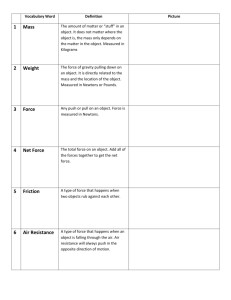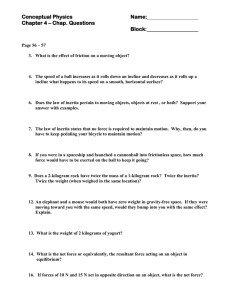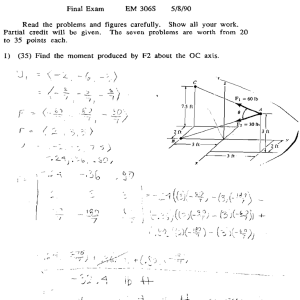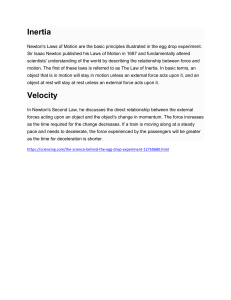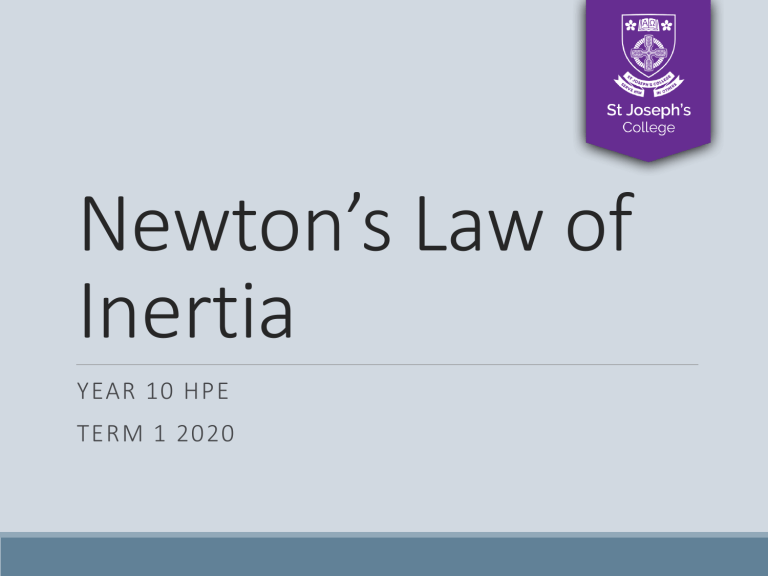
Newton’s Law of Inertia YEAR 10 HPE TERM 1 2020 Newton’s Law of Inertia: First Law Newton’s Law of Inertia states that: “That a body will continue in its state of rest or constant velocity in a straight line unless it is acted upon by an external force.” In other words, an object will not move or change the way it is moving until a force causes it to do so. Forces may cause an object to speed up, slow down, change shape, change direction or start to rotate. In a simple example, a golf ball will remain stationary on a tee until it is struck by a club. This tendency to remain at rest or in the same state of motion is known as inertia, which can be considered as an object’s resistance to changing its state of motion. Inertia Inertia is sometimes difficult to realise because of the effects of the force of gravity. An example can be seen in the slinging of a discus. The discus will not move until the muscles of the thrower provide a force to start its motion. After the discus is slung, it does not remain in the same motion because the force of gravity acts to pull to the ground and air resistance acts to slow it down. The law of inertia could be well illustrated in space where, without gravity or air resistance to change the inertia of an object after it has been set in motion, it will continue in the same direction at the same velocity. Inertia Example Inertia affects many aspects of sport. E.g. a soccer ball becomes wet, its additional mass gives it a higher inertia. This will make it more difficult for players to: ◦ start the ball moving when it is stationary ◦ slow the ball down or speed it up when it is already moving ◦ stop the ball when it is moving. In indoor soccer, where the game is played in a confined area, players use a smaller, lighter ball with a lower inertia than a normal soccer ball. This makes it easier for players to: ◦ start the ball moving when it is stationary ◦ slow the ball down or speed it up when it is already moving ◦ stop the ball when it is moving. Rotational Inertia If the motion is rotational, that is turning around an axis, you have to consider not only the object’s mass, but the distance of the mass from the axis of rotation. Examples can be found in skills such as: ◦ Swinging around a gymnastics bar, ◦ Swinging a golf club ◦ The hammer throw The rotational inertia of an object can be calculated using the formula: I = mr2 where: ◦ I = inertia ◦ m = mass ◦ r = radius of rotation Example Rotational Inertia Mass The larger the mass of an object, the greater its resistance to rotational movement, and the greater its persistence once it does start moving. E.g. a heavy cricket bat will be more difficult to swing than a lighter cricket bat, but once it starts moving it will be more difficult to stop. Radius of Rotation The further the mass of an object is distributed away from the axis of rotation, the greater is its resistance to rotational movement, and the greater will be its persistence once it does start moving. E.g. the axis of rotation of a cricket bat is where the hands grip the bat. The further the mass of the bat is distributed away from the hands, the harder the bat will be to swing. If the bat is weighted more at the end than near the handle, it will be more difficult to swing than a bat of the same mass which is not weighted at the end. Conversely, 'choking the grip' by dropping the hands further down the handle will bring the mass closer to the axis of rotation, and make the bat easier to swing. Changing Rotational Inertia As mass is difficult to adjust, changes in the rotational inertia of object are usually made by adjusting the radius of rotation. In sport radius adjustments can be made at will during the performance of a skill. E.g. a spinning ice-skater can increase her or his radius of rotation by extending her or his arms (see next slide), or a cricketer can reduce her or his radius of rotation by moving her or his hand down the grip. Mass changes can be made only by using objects of different mass, for example, a heavier softball bat, or, in the case of part of the body, by changing muscle bulk over an extended time. High rotational inertia A body with a high rotational inertia will have all the following characteristics, although not all of these may have a practical application within one specific sports skill. The body will be: ◦ resistant to change of rotational motion, for example, a rotating hammer thrower ◦ steadier, for example, a skater spinning with arms extended ◦ hard to accelerate and decelerate, for example, a golf club at the beginning of a backswing ◦ slow-moving, for example, a layout somersault compared to a tuck somersault ◦ hard to stop, for example, a swinging softball bat just before impact with the ball. Low Rotational Inertia A body with a low rotational inertia will have all the following characteristics, although not all of these may have a practical application within one specific sports skill. The body will be: ◦ responsive to change of rotational motion, for example, a runner's flexed recovery leg ◦ less steady, for example, a gymnast pirouetting on the Olympic beam ◦ easy to accelerate and decelerate, for example, a child's cricket bat, compared to a full-size bat fast-moving, for example, an ice-skater spinning in a tuck position ◦ easy to stop, for example, a spinning golf ball with greater mass in the core than on the softer cover. Example Lleyton Hewitt, bending the non-striking arm into the chest to increase the rotational velocity of the shoulders and striking arm. Newton’s law of acceleration: Second Law Newton’s law of acceleration states that. “Any change in motion is directly proportional to the applied force and is made in the line of force”. This law is expressed by the following formula: F = ma where: ◦ F = force ◦ m = mass ◦ a = acceleration No force can be started without the application of a force. When a force is applied to an object it will move in the direction the force was applied and depending on the size of the object, the object will accelerate accordingly. A smaller object will move faster than a larger object A greater force will move an object faster than a smaller force. nd Newton’s 2 law E.g of Newton’s 2ns law. ◦ When a runner wants to leave the blocks a force has to be exerted against the blocks. ◦ When a footballer wants to push an opponent out of the way a force has to be exerted against the opponent, ◦ When an archer wants to shoot an arrow, a force has to be exerted to pull back the bowstring. Force can therefore be defined as a pushing/pulling or hitting/ throwing action which is applied to an object to start movement, stop movement or cause changes in movement. e.g. ◦ When a batter in cricket applies a hitting force to a cricket ball, the ball will immediately move off the bat. ◦ The amount of force created by the bat is equal to the force taken up by the ball. ◦ Because the ball is now in motion, its force can be described in terms of its mass and acceleration away from the bat. Force recap The mass of a hockey ball stays the same during a game of field hockey. Therefore if a hockey player doubles the force of a hit by doubling the swing speed, the acceleration of the ball off the stick will also double (see diagram below) Newton’s law of actionreaction: Third Law Newton’s law of action and reaction states that: ◦ “For every action force or momentum, there is an equal and opposite reaction force or momentum”. According to this law of action and reaction, the forces that two bodies exert on each other are: ◦ Opposite in direction ◦ Equal in magnitude You have a general understanding of this law through your own everyday experiences. E.g. if you head a soccer ball that is wet and heavy, it can hurt your head. The ball not only receives a force from your head, but your head also receives a force back from the ball. rd Newton’s 3 Law If an athlete exerts a force onto the ground in order to push off, the ground will exert an equal and opposite force on the athlete, pushing them up into the air. The first force of the athlete pushing the ground is called an action force. The second force is called the reaction force (when the second body applies an opposing force back. Example Volleyball Serve / Spike: Newtons 1st Law: A player on the balls of their feet to move in the direction of the ball. Volleyball Serve: nd Newtons 2 Law: Large Step to build speed Change direction of force vertically needs good knee bend plus greater time to apply force. Arm travels more distance...more speed... Therefore more acceleration!!! Volleyball Serve: rd Newtons 3 Law Push against floor for jump Pull non striking arm down to create more speed for striking arm Legs forward at impact Practical Application With your partner, provide a summary of 1 of the following sports according to Newton’s 3 Laws of Inertia: Volleyball dig; Cricket cover drive; Tennis forehand; Badminton overhead shot; and Hockey push shot. Glossary At the end of each lesson write your definition of the following terms to check your understanding and help prepare you for the end of term exam. (This can be done in your workbook, OneNote or in Word saved to your OneDrive) • • • • • • Newtons 1st Law Inertia Rotational Inertia Newtons 2nd Law Newtons 3rd Law Mass

